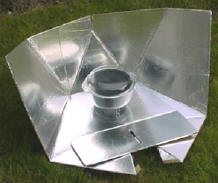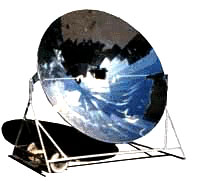solar cooker
A solar cooker is a type of solar collector that concentrates solar radiation with the help of a reflecting surface on the back, top, and bottom sides of a container. There are three main types: the box-style cooker, the panel cooker, and the parabolic cooker. Each type has pros and cons when compared on its heating ability, ease of construction, and ease and safety of use.
Box cookers
 |
These are the most common for personal use. Despite the name "box" cooker, they are made in both circular and rectangular shapes. They consist of an enclosed inner box covered with clear glass or plastic, a reflector, and insulation. The pot is placed inside and the open cover points the sun's rays at the pot.
Many different patterns and plans are available that can be adapted to work with whatever materials are to hand. While box cookers don't heat quickly, they provide slow, even cooking. They are also very easy and safe to use, and fairly easy to construct.
Panel cookers
 |
These are flat reflective panels that focus the sunlight onto a cooking vessel without the inner box common in box cookers. Panel cookers are the easiest and least costly to make, requiring just four reflective panels and a cooking vessel; however, they are unstable in high winds and don't retain as much heat when the sun is hidden behind clouds.
Parabolic cookers
These reach higher temperatures and cook more quickly than box or panel cookers, but are harder to make and use. Most commercial solar ovens are of the parabolic variety. Parabolic cookers require more precision to focus the sunlight on the cooking vessel. If the sunlight isn't focused exactly, the food will not cook. More expensive versions have a built-in tracking device which automatically follows the sun; other the tracking has to be done by hand.
 |
When the parabolic oven is used, the temperature must be watched so the vessel doesn't overheat, burning the food. With a diameter of 140 centimeters, corresponding to an output of 600 watts, they need about 25 minutes to bring 3 liters of water to a boil; with half that diameter, a 150 watts output, it would take about 40 minutes to boil just 1 litre of water. The risk of burns and eye injury is greater with homemade parabolic designs. While they provide excellent results when used correctly, they are not easy to build at home and require great care to use.
